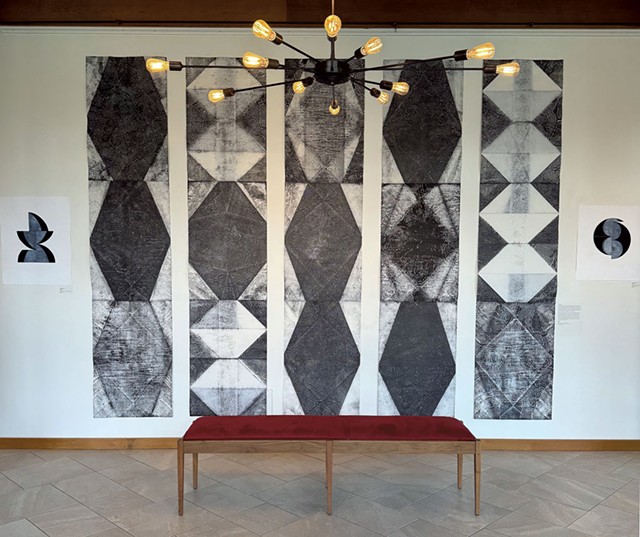
- Courtesy
- "Shadows" by Patty Hudak
In a world rife with printed material, why make more? Printmaking may be the least understood art medium, even as it's arguably the most straightforward. The gulf is wide between what rolls rapidly off an automated printing press — such as this newspaper — and what emerges from designing and inking one sheet at a time. A close observer will see that no two handmade prints using the same plate are exactly alike. Call it slow art with a side of serendipity.
Looking closely is just what Vermont artists Patty Hudak, Carol MacDonald, Susan Smereka and Elise Whittemore invite viewers to do at their exhibit "Unique Similarities: Four Printmakers Expand the Matrix." Curated by Maureen O'Connor Burgess, it's on display at Highland Center for the Arts in Greensboro.
The first part of the title could describe both the slight variations among multiple pressings of an inked plate and the four artists' singular approaches to their medium.
Visitors to the expansive, light-filled gallery will likely notice first what the artworks have in common: ink on paper, a limited palette of (mostly) black and white, a vocabulary of geometric forms. Multiple artists here use the techniques of sewing, folding and collaging. The aesthetic cohesiveness has a calming effect: It's oddly liberating to explore an exhibition without being influenced by color or representational content.
Yet all four women's artist statements reveal there's more personal meaning in their works than meets the eye.
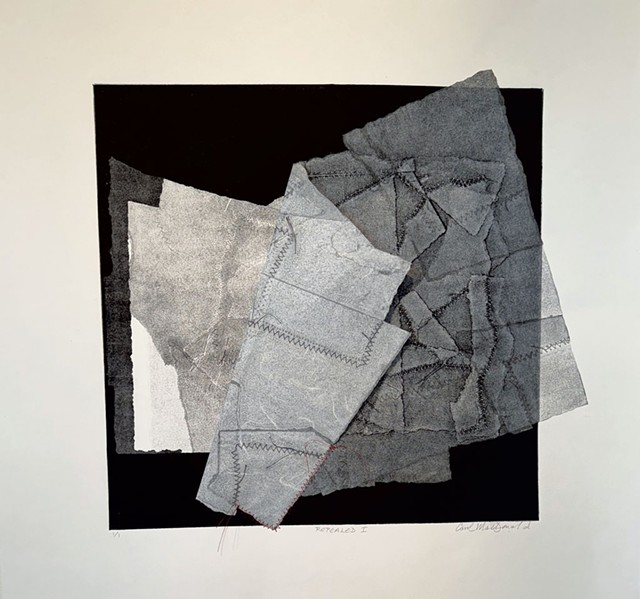
- Courtesy
- "Repealed I" by Carol MacDonald
MacDonald has previously addressed trauma in her work, using imagery such as repaired garments and knitting to represent recovery. In a 2020 exhibition at the Rokeby Museum, "Mending Fences," she deployed knotted red cord to literally bind split-rail fences on the grounds. That exhibit "opened the whole question of racism and did I need to do my own work around it?" she said in a phone interview. The murder of George Floyd and the Black Lives Matter protests cemented her resolve to undergo that personal examination.
She began a series of monotypes in 2021 "as an exploration of my whiteness in the face of racism in America," she writes in her statement. Like most printmakers, MacDonald had typically worked with black ink on white paper. This time, she reversed the process: white on black. Her prints at the Highland Center are collages of previous work that she ripped up and reassembled. Many of the pieces are joined with a zigzag stitch — a personal kintsugi.
With her artist statement in mind, the viewer can't help but see MacDonald's black, white and gray-toned works as metaphors.
"Always my work comes from a place in me and my story about it," she said. "My hope is that it resonates with people on some level, that some energy gets transmitted."
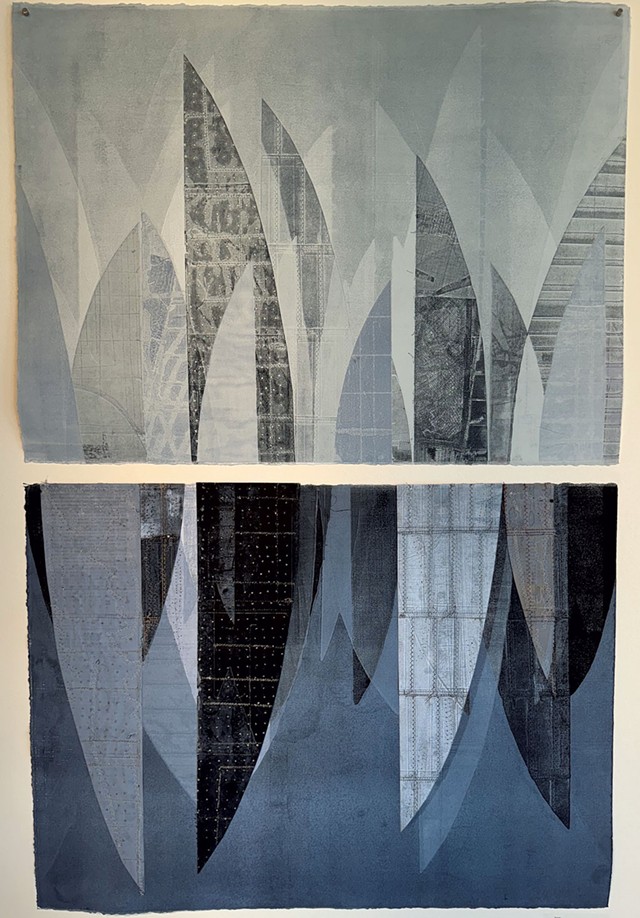
- Courtesy
- "in the end" and "can't see" by Susan Smereka
Smereka's monotypes also incorporate collage and sewing, as well as repurposed pieces of previous work and other elements. Her work has a bold graphic sensibility and wields repetition as if to drive home a point. One particularly striking motif resembles a knife or shard. A forest of these shapes dominates Smereka's 22-by-30-inch monotypes "in the end" and "can't see." In other pieces, she lops off part of the shape to create a fragment — an arc, a trapezoid — taming its blade.
Reading her artist statement about blood relatives and chosen connections brings new dimensions to Smereka's compositions. "Part of our family story is a history you carry — an epigenetic transference from our ancestors that plays out unconsciously," she writes. "Printmaking is a process that shows an impression of something. The actual surface is not there."
By phone, Smereka explained that making prints enables her to process aspects of an internal life that viewers may intuit, though they aren't visible to the eye. "Sometimes it's personal and sometimes it's universal," she said. "Or that's my hope. Everybody seems to have a story about their family, good and bad."
Her own story involves the suicide of a sibling nearly a decade ago, Smereka revealed. "I've been trying to process that in various ways."
At another level, she continued, the stitching in her collages harks back to the history of "women's work." "What women made with fabric was what they owned," she said. "They didn't own their children, their land, money. They owned their tapestries. There's a lot of pride in that."
Hudak's work explores the interconnectedness of the natural world. Unlike the other three printmakers, who primarily make monotypes, she carves woodblocks and creates images with sumi ink using the Japanese technique called mokuhanga. For this exhibit, she made 28-by-114-inch prints from an oversize block. Folding and re-pressing her washi paper, Hudak was able to print on both sides, creating more depth.
At the center of the gallery, an installation of large prints she calls "Shadows" is stacked three high and five wide. Each piece features one or two loose diamond shapes; together they resemble totems, their graphic impact both primitive and modernist.
These shapes have a particular resonance for Hudak. In Japan and in her mother's ancestral home of Ireland, she has observed sacred spaces marked in the landscape. "We don't have any record of that here," she said by phone. "[During the pandemic], I started to spend more time in nature and to experience it as sacred. It's this idea of transcending the scientific side of nature and entering the mystical side."
Several of her prints hang in the gallery's windows, where light can pass through them à la stained glass. Ghostly botanical elements intersect with diamond shapes, rendering the works mystical indeed.
"I hope that when people view my work, they feel this miracle, this spirit," Hudak said.
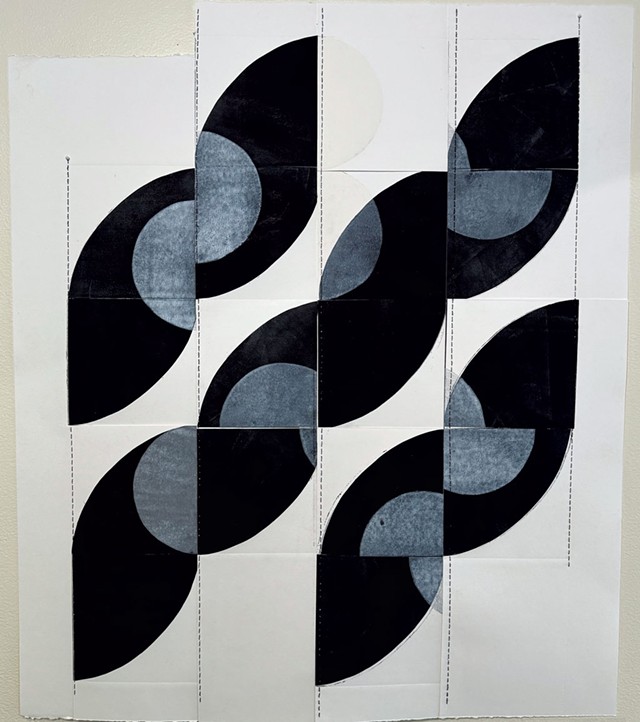
- Courtesy
- "Wander III" by Elise Whittemore
A circle likewise has cosmic associations, as well as a bold presence in black, white and gray on stark white paper. It's a shape that Whittemore continues to splice and compose in seemingly endless variations. "I'm not done with it yet," she said by phone. But she begins with a square.
Whittemore said her monotypes are "built using the idea of a quilt block." Though she's not a quilter herself, she remembers watching her mother, who would "lay a square, cut it up, maybe rotate it." That's what she does with her squares, from which circles emerge. Imagine the shape cut in halves, quarters, eighths and then rearranged in inventive ways. In "Wander III," for example, the composition resembles three diagonal black-and-gray twists, like ribbon or pastries.
Enamored of the circle's geometric potential, Whittemore is also driven to subtraction: "In this series I was looking at how minimal [the designs] could get," she said. "What can I reduce down and still make something?"
Like Smereka, she appreciates the lineage of women's sewing skills. Though her artist statement for this exhibit is minimal, on her website Whittemore observes "how elements of [quilters'] designs could reflect ideas of home and their environment."
"Unique Similarities" is rich in personal semaphores and female energy. Though the artists' only collective agreement was the restricted palette, Whittemore acknowledged that all their works demonstrate "a sense of building up."
"There's kind of a somber tone to it, for a summer exhibit in Vermont," Hudak opined. "There's an exploration of black and shades of gray. And where does white fit in? I feel we're expressing something of a lifeline."





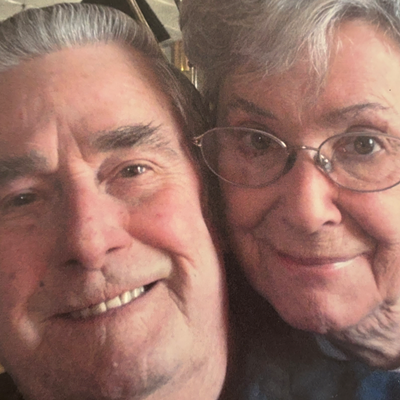
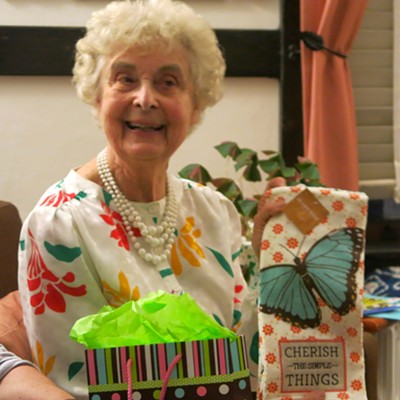
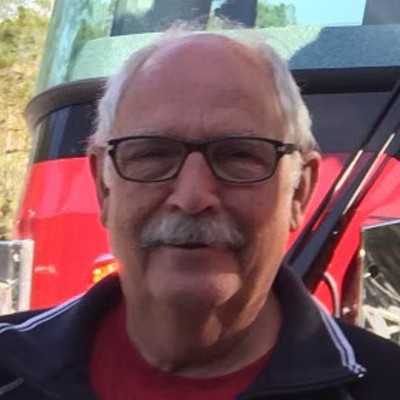
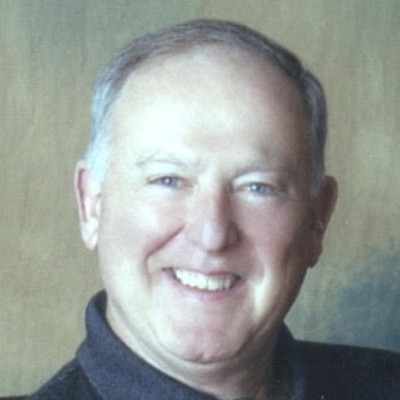
Comments
Comments are closed.
From 2014-2020, Seven Days allowed readers to comment on all stories posted on our website. While we've appreciated the suggestions and insights, right now Seven Days is prioritizing our core mission — producing high-quality, responsible local journalism — over moderating online debates between readers.
To criticize, correct or praise our reporting, please send us a letter to the editor or send us a tip. We’ll check it out and report the results.
Online comments may return when we have better tech tools for managing them. Thanks for reading.